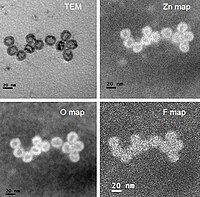
Photo from wikipedia
Abstract A new reverse microemulsion system is proposed for the first time to synthesize NaYF4:Yb,Er nanocrystals, which demonstrated high upconversion emission in 550 and 662 nm at 980 nm diode laser excitation. The… Click to show full abstract
Abstract A new reverse microemulsion system is proposed for the first time to synthesize NaYF4:Yb,Er nanocrystals, which demonstrated high upconversion emission in 550 and 662 nm at 980 nm diode laser excitation. The reverse microemulsion (μEs) system is comprised of CTAB and oleic acid as surfactant and 1-butanol co-surfactant and isooctane oil phase. The surfactant to water ratio is able to tune the microemulsion droplet size from 14 to 220 nm, which eventually controls the crystallinity and particulate morphology of NaYF4:Yb,Er. Also, the microemulsion precursor and calcination temperature plays certain role in transforming the cubic NaYF4:Yb,Er to highly luminescent hexagonal crystal structured upconversion material. Single phase hexagonal NaYF4:YbEr nanorod prepared by water-in-oil reverse microemulsion (μEs) gives intense red upconversion emission. Both nanosphere and nanorod shaped NaYF4:Yb,Er was obtained, but nanorod morphology resulted an enhanced upconversion luminescence. The structural, morphological, thermal and optical luminescence properties of the NaYF4:Yb,Er nanoparticles are discussed in detail by employing powder X-ray diffraction, dynamic light scattering, high resolution electron microscopy, TGA-DTA, UV-DRS, FTIR and photoluminescence spectroscopy. Intense upconversion emission achieved in the microemulsion synthesized NaYF4:Yb3+,Er3+ nanocrystal can make it as useful optical phosphor for solar cell applications.
Journal Title: Optical Materials
Year Published: 2018
Link to full text (if available)
Share on Social Media: Sign Up to like & get
recommendations!